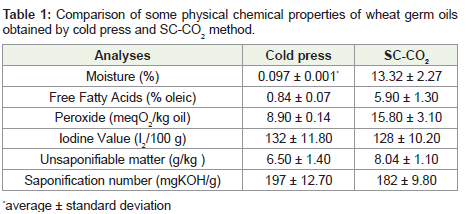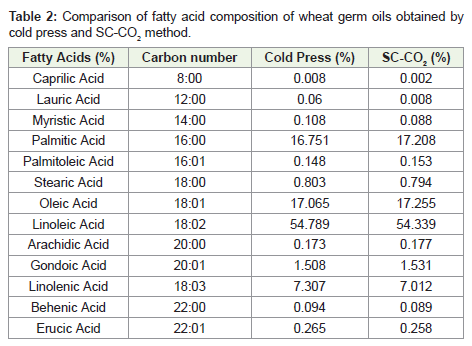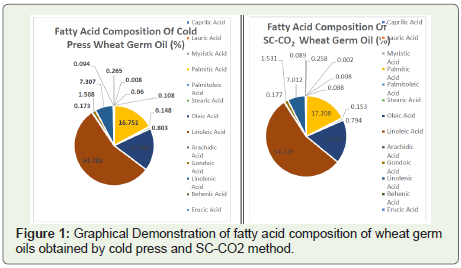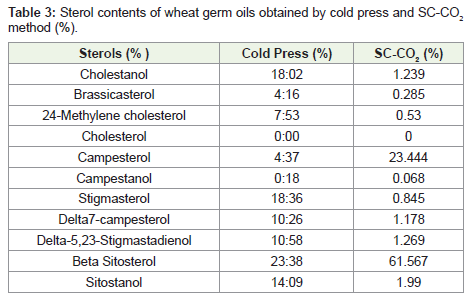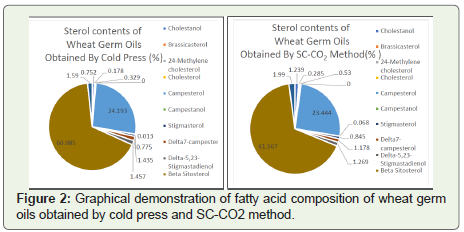Research Article
Comparison of Some Physical Chemical Properties of Wheat Germ Oils Obtained By Cold Press and Super Carbon Dioxide Extraction Method
Derya Duran*
*Corresponding author: Derya Duran, Graduate School of Natural and Applied Science, Food Engineering, TurkeyYazır region, Akkonak street, Gesapark City Selcuklu/Konya, Turkey; E-mail: derya.orn@gmail.com
Article Information: Submission: 18/11/2019; Accepted: 27/12/2019; Published: 31/12/2019
Copyright: © 2019 Duran D. This is an open access article distributed under the Creative Commons Attribution License, which
permits unrestricted use, distribution, and reproduction in any medium, provided the original work is properly cited.
Abstract
In this study, moisture, free fatty acids, peroxide, iodine number, the amount of unsaponifiable matter, saponification number, fatty acid composition
and sterol analyzes were carried out to determine physicochemical properties of germ oils obtained by cold press and supercritical carbon dioxide extraction
method. While the maximum oil yield was found to be 1% as a result of cold pressing process to obtain oil from germ raw material, the maximum oil yield
was found to be 9% as a result of the supercritical carbon dioxide process which is another one of the oil extraction methods. The dominant fatty acids in the
samples were palmitic, oleic and linoleic acid. And these values were for cold press and SC-CO2 extraction wheat germ oil respectively; for palmitic acids
16,751% and 17,208%, for oleic acids 17, 065% and17,255%, for linoleic acids 54,789% and 54,339% determined. When sterol analysis of oils extracted by
both methods is examined, campasterol and beta sitosterol are seen to be the main sterol varieties found in the oils. In germ oils obtained with cold press and
supercritical carbon dioxide extraction methods, respectively, 24,19 and 23,44% campesterol, and 60,98 and 61,56% beta sitosterol were found. This study
showed that there was not much difference between fatty acid compositions and sterol composition between extracted oils in both extraction methods, but
that there were differences in free fatty acids and peroxide values. Cold press wheat germ oil peroxide value was found 8.90 meqO2/kg oil whereas SC-CO2
peroxide value was found 15.80 meqO2/kg oil.
Keywords
Wheat germ oil; Cold pres; Super critical carbon dioxide extraction; Sterols; Fatty acids
Introduction
Wheat consists of endosperm, bran and germ, and these ratios
approximately vary between 81-84%, 14-16% and 2-3% respectively
[1]. The maximum yield is obtained from endosperm when wheat
is ground for flour production. Germ is a by-product of wheat flour
industry.
Wheat varieties contain different amounts of oil depending on the
type. Wheat seed has a lipid content of 2-4%. Wheat germ contains
8-14% fat. Wheat germ is a by-product in the flour industry. It has a
very high nutritional content. It contains about 52% carbohydrate,
23% protein, 11% water, 10% fat and 4% ash. Thanks to its tocopherol
content, it has high nutritional value among vegetable oils [2].
Mechanical extraction (pressing) or organic solvent extraction
is one of the most commonly used methods for germ oil. Solvent
extraction is the most commonly used method [3].
In germ oil extraction, supercritical carbon dioxide extraction
and cold press are some of the oil extraction methods [4].
Germ oil has the highest tocopherol content among all vegetable
oils. Its tocopherol content is about 2500 mg/kg and it also has the
highest α-tocopherol content which is 60% of its total tocopherol
content [2]. Germ oil also has high content of unsaturated fatty acids.
These are around 80%. Generally, it has a high proportion of linoleic
(18:2) and linolenic (18:3) acid [5]. Both of these are important for
the human metabolism and cannot be produced by the body. They
are precursors to the production of a group of hormones called
prostaglandin and support the development and improvement of
muscle structure and inflammation system [6]. In addition, linoleic
acid helps to lower cholesterol and is precursor to phospholipids of
the cell membrane [7].
In this study, wheat germ oil will be extracted by cold press method, applied without high heat treatment to preserve its
nutritional properties and with supercritical carbon dioxide
extraction in accordance with today’s modern technology; and
determining characteristics, such as the moisture, free fatty acids,
peroxide, iodine number, the amount of unsaponifiable matter,
saponification number, fatty acid and sterol values of the extracted
oils were evaluated and compared.
Material and Method
Material:
Wheat germ was used as raw material in the research. Germ was
procured from Altınapa Milling Inc.Method:
Procuring germ oil: Obtaining germ oil with cold press method: Cold press oils: Oils obtained only by mechanical methods without heat treatment.The oil extraction by cold pressing method with the raw
material of the supplied germ was carried out at Helvacizade Food
Pharmaceutical Chemicals Inc. The extracted oils were hermetically
sealed and are kept away from sunlight and heat.
Obtaining germ oil with supercritical carbon dioxide extraction:
Supercritical carbon dioxide extraction was performed under
laboratory conditions [8,9]. The lab consists of 400 m3 extraction tank
and 200 and 300 m3 2 separator tanks. Extraction is a semi-continuous
system. It is fed with vegetable material and continuous solvent flow.
Germ oil was extracted by using only one separator at 40 °C at 200,
250 and 300 bar pressure [10].Physical analyses:
Determination of moisture content: Moisture content of wheat
germ was determined using TS 1607 ISO 662 method with drying
oven technique [11].Chemical analyses:
The fatty acids, peroxide number, iodine number, saponification
number and the amount of unsaponifiable matter in oils obtained
by cold press and SC-CO2 were determined. These analyzes were
conducted with the following methods; TSE 894, TS 4964 ISO 3960,
TS EN ISO 3961, TS EN ISO 3657, TS 4963 respectively [12-16]. In
addition, fatty acid composition was determined with the TS EN ISO
12966-1 method and determination of sterol was made with the TS
EN ISO 12228-1 method [17,18].Results
The moisture, free fatty acids, peroxide, iodine number, the
amount of unsaponifiable matter (%), and saponification number
of germ oils obtained by supercritical carbon dioxide extraction and
cold press method are given in the Table 1.
When the physicochemical properties of germ oil obtained by
cold press method were examined, the values were determined as
follows; moisture 0.097%, free fatty acids 0.84%, peroxide 8.9 meqO2/kg, iodine 132, unsaponifiable matter 6.5 g/kg, saponification number
197 mgKOH/g oil. And in oils obtained by supercritical carbon dioxide
extraction method, these properties were; moisture, 13.32%, free fatty
acids, 5.9%, peroxide 15.8 meqO2/kg, iodine 128, unsaponifiable
matter 8,04 g/kg, saponification number 182 mgKOH/g oil.
Fatty acid composition:
Fatty acid compositions of germ oils obtained using supercritical
carbon dioxide extraction and cold press methods are given in Table
2.In the acid composition of the oils extracted by both methods
herein; 8:0, 12:0, 14:0, 16:0, 16:1, 18:0, 18:1, 18:2, 20:0, 20:1, 18:3,
22:0, 22:1 fatty acids were examined. The main fatty acids in the oil
extracted by both methods were determined as palmitic, oleic and
linoleic (Figure 1).
Table 1: Comparison of some physical chemical properties of wheat germ oils
obtained by cold press and SC-CO2 method.
Table 2: Comparison of fatty acid composition of wheat germ oils obtained by
cold press and SC-CO2 method.
Figure 1: Graphical Demonstration of fatty acid composition of wheat germ
oils obtained by cold press and SC-CO2 method.
Germ oil has mostly linoleic acid 59.4%, followed by 18.8%
palmitic acid and 14.3% oleic acid [19]. These values are close to the
values present in the literature [5,20].
Sterol value:
Sterol values of germ oils obtained with supercritical carbon
dioxide extraction and cold press methods are given in Table 3.When sterol analysis of oils extracted by both methods is
examined, campasterol and beta sitosterol are seen to be the main
sterol varieties found in the oils. In germ oils obtained with cold press
and supercritical carbon dioxide extraction methods, respectively,
24,19 and 23,44% campesterol, and 60,98 and 61,56% beta sitosterol
were found (Figure 2).
Discussion
In their study, Jiang and Niu, (2011) determined the physical
and chemical properties of germ oil obtained by different methods as
follows; in the germ oil extracted by SE method, moisture, 0.68±0.02,
acid value, 12.8±0.8 mgKOH/g, peroxide number 2.95±0.04 mmol/
kg, saponification number 121.5±1.98 mgKOH/g, iodine number
142.8±1.85, amount of unsaponifiable matter 3.34±0.05% and in
the germ oils extracted by SFE method, moisture, 0.47±0.08, acid
value, 9.1±0.2 mgKOH/g, peroxide number 2.05±0.09 mmol/
kg, saponification number 169.3±1.52 mgKOH/g, iodine number
149.1±1.34, amount of unsaponifiable matter 4.16±0.08%. These
results showed that the quality of germ oil obtained by SFE is higher.
Particularly, the acid value, peroxide number and color of germ oil
are of better quality than germ oil obtained by SE method. This is
because in SFE, the bioactive components without the use of any solvent with low pressure (30 MPa), short extraction time (1.7 hours)
and low temperature (40 °C).
Figure 2: Graphical demonstration of fatty acid composition of wheat germ
oils obtained by cold press and SC-CO2 method.
In this study, physicochemical properties of germ oil obtained
by supercritical carbon dioxide extraction and cold press were
investigated and results except moisture, free fatty acids and peroxide
were found to be close to each other. The reason for the difference
between the values were due to conditions of storage, preservation
etc. [21].
The average temperature in germ oil obtained by cold press is
around 40 °C. When the moisture content, as one of physicochemical
properties of the oils obtained with these methods is examined, it was
found to be 0.097%, in cold press and 13.32% in supercritical carbon
dioxide extraction. The moisture was determined using the special
drying oven method. There is a significant difference between these
results. This is probably due to storage conditions of the raw material
or extraction conditions during oil extraction [21]. It was reported
that the moisture content of the product may vary depending on the
extraction conditions and the moisture content of the raw material
[22-24]. In SC-CO2s with industrial grade production vegetable oils
must be separated before pressure process with high water content.
State that fatty acid compositions of germ oils are similar in
both supercritical and hexane extraction methods [25]. State that as
a result of their study, there were no major differences between the
fatty acid compositions of refined germ oil and germ oil produced
with supercritical technology.
The comparative results of the fatty acids composition of germ oil
produced by SC-CO2 and cold press are given in Table 2. They were
observed to be parallel with the values stated in the literature, there
was not much difference between the results.
Therefore, the fatty acid composition does not differ much
depending on the extraction technique.
Phytosterols are major components of the non-saponifying
portion of germ oil. According to Itoh et al. (1973) [26], germ oil
contains a higher proportion of phytosterol than other commercial
oils. Sitosterol (60-70%) and campesterol (20-30%) are the two major
sterols found in germ oil [27,28]. Most phytosterols in germ oil are
present in ester form [29].
In this study, germ oil was extracted by supercritical carbon
dioxide extraction and cold press methods and the comparative
results are given in Table 2. When the results are examined, as
indicated in the literature, the main vegetable sterol was found to be
beta sitosterol (approximately 60% of the total sterols) followed by
campasterol (about 25% of total sterols).
Conclusion
This study was carried out to extract oil from the raw germ
material using supercritical carbon dioxide extraction and cold
press methods. Germ oil is among the functional foods and contains
many components that are beneficial to human health. This study
demonstrated that germ oil has a high content of unsaturated fat and
useful phytosterols, regardless of the method of extraction. However,
in terms of physicochemical properties, the amount of moisture, free fatty acids, peroxide and amount of unsaponifiable matter were lower
in the germ oil obtained by cold press, and the number of iodine and
saponification was lower in the oil obtained by supercritical carbon
dioxide extraction.
Along with the importance of the oil extraction method, germ oil
contains many nutritionally beneficial components. Cold press has
hence drawn the interest of consumers because of nutritional contents
and naturality of the oils. Since no heat treatment and chemical
process is used during the cold press process, all beneficial nutritional
properties of the raw material are transmitted to the oil. Therefore,
cold pressed seed oils have high dietary and sensory properties, and
contain useful elements with significant chemical properties for
health. Cold pressed seed oils contain natural phytochemicals such as
tocopherols, fatty acids, sterols and antioxidant phenolic compounds.
And wheat germ oil contains, beneficial unsaturated fatty acids,
sterols so it is beneficial for human health.

